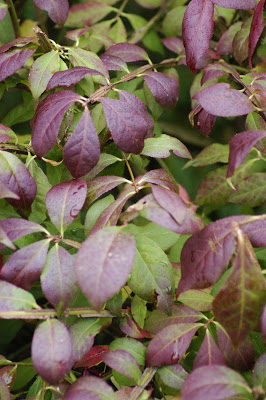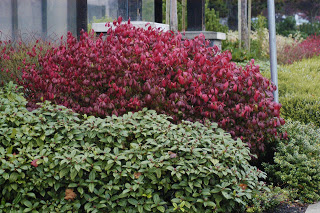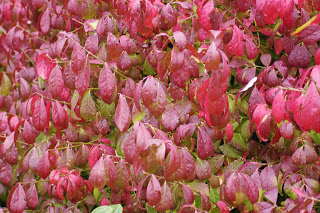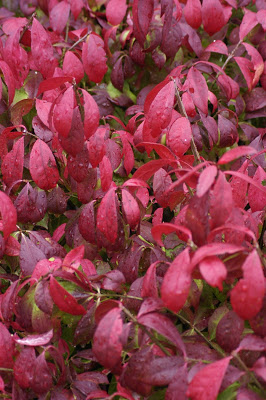 |
| Euonymous alatus “Compactus” |
Dwarf Burning Bush
Euonymous alatus “Compactus”
Type: Deciduous Shrub
Exposure: Sun / Part Shade
Water: Regular
Native to Japan, China,and Korea, this shrub’s biblical-sounding name refers to the brilliant red leaf color in fall. And, as you might expect, “compactus” refers to the fact that this a dwarf cultivar, but only when compared to the full-sized burning bush, which can reach 30ft (9m) high. This one will reach 10ft (3m) high and wide if left to its own devices, but it can be kept much smaller by pruning or shaping; its strong branching structure makes this very feasible. For this same reason, they make for an effective hedge. If you prune or shear them in autumn, though, you’re liable to end up removing the bright red leaves, revealing the green and maroon ones underneath (see last photo, above). Also, there’s an even more scaled-down cultivar, “Rudy Haag,” available which tops out at 5ft (1.5m) high and wide.
Winter branches can have an interesting corky bark that make them look sort of square, although this trait is less pronounced in the dwarf cultivars (you can see it in the last photo if you squint). These are also referred to as “wings,” so burning bush is sometimes called “winged euonymous.” These branches sprout dark green, oval leaves that tend to curl downward. These are followed by small, rather insignificant flowers in the spring, which in turn give rise to attractive red capsules in autumn, which split to reveal orangy seeds. However, these are often hidden by the similarly-colored foliage.
I was unsure about posting this plant, for a couple of reasons. The first is that it is considered by many to be an overused, sort of “commercial” style shrub that half of the year just isn’t all that attractive anyway, but they are a very common sight in garden centers, and I know many people who just love theirs. So I’ll let you make up your own mind on that point.
The second reason is that burning bush is considered invasive in 3 states in the Northeastern US: Massachusetts, Connecticut, and New Hampshire, and one site mentioned issues in Ontario, the south and the midwest. To my knowledge, there is no problem with that here in zone USDA 8, presumably because of the strength of the competing native understory, but please let us know if you have any knowledge to the contrary. Anyway, be warned, my New England friends.
Cheers
John



